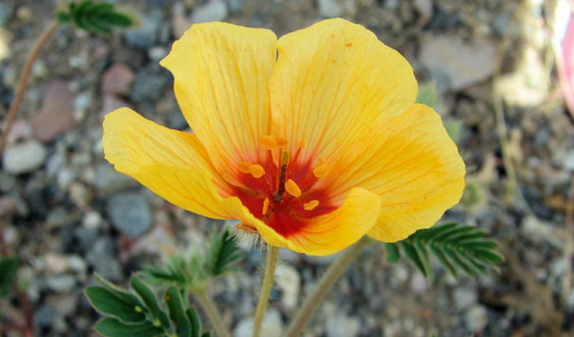
August Means Arizona Poppies
July 12, 2017One does not normally think of the desert blooming in the summertime, since most of the showy annuals we are familiar with appear in the spring. However, the Arizona Poppy (which is not actually a poppy) is a striking exception, usually blooming after the start of the summer rains, July through September. The bright orange flowers (1”-3”) are veined with red and can sometimes rival a display of Mexican Gold Poppies. Plants can reach 3”-5” across and up to 1 ½” tall and may be found throughout the lower elevations of Southwestern North America.
Lacking any fragrance, pollinators still find the flowers most attractive, particularly our native bees, but wasps, flies and butterflies will also partake of the nectar and pollen on offer. Naturalist David B. Williams writes:
“The great variety of visitors utilize the flowers in four distinct ways. Unlike many insect visitors to plants, three groups do not play a role in pollination. One group avoids the anthers and stigma by being too small. A second group, including honeybees and larger wasps, extract nectar from under the flower. A third clan only stops by for nectar. A fourth group gathers pollen and nectar from within the flower and contributes to both cross- and self-pollination. Researchers hypothesized that the non-pollinating visitors ‘contributed to the economy of the plant by reducing the quantity of available nectar so that the pollinators have to visit more flowers to get their full nectar supply’.”
The resulting seeds are an important food source for doves and quail.
Caltrops are so named because the fruits of many of the species are shaped like military caltrops, pointy metal objects designed to be strewn in the path of advancing troops to impede their progress by injuring the feet of men or horses, in the case of the cavalry, by puncturing a vehicle’s tires today. Other members of the caltrop family include creosote bush and the introduced European Puncture Vine, also known as Goat-head because the seeds resemble the horned head of a goat. Puncture Vine is a common summer weed in lawns and disturbed areas, an extremely obnoxious plant with the capability of poking holes in flip-flopped feet, or even puncturing a tire. Its well-earned scientific name is Tribulus terrestris — scourge of the earth!
Look for Arizona Poppy along the roadside up and down Oracle Road, north to the Junction. The best viewing should be late summer (August through early September), assuming sufficient summer rainfall.
